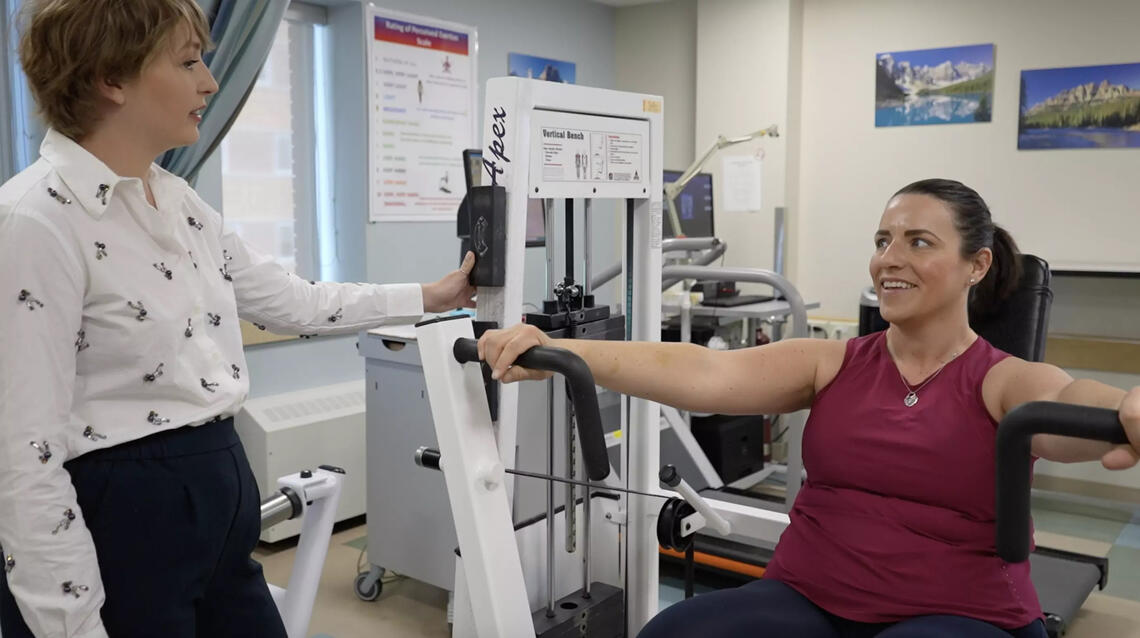June 1, 2023
UCalgary researchers study impact of physical activity on adolescents and young adults after cancer treatment

Cancer treatment and research often focus on people who currently have cancer and ways to help them survive — but what happens once they have completed treatment?
Treating cancer can lead to lasting effects, and survivors can be left with physical and emotional impacts long after treatment is over. This situation can be especially draining for adolescents and young adults (AYAs) — a group ranging in age from 15 to 39 — who still have their studies or careers, family planning and long lives ahead of them.
Cancer rates for this group are increasing, with around 7,600 people diagnosed yearly in Canada. However, this demographic also has an 85 per cent survival rate after five years. While survival rates are encouraging, there is an associated "cost" with cure and, with longer-expected lifespans, this means potentially decades of living with the lasting effects of cancer and its treatment.
A research project from a team of researchers at the Cumming School of Medicine (CSM), Adolescents and Young Adults Becoming Physically Active After Cancer Trial (AYA-PACT), is investigating if physical activity after cancer treatment could potentially improve AYAs’ health outcomes. The study, funded by the Canadian Institutes for Health Research (CIHR), is currently seeking additional participants who meet the eligibility criteria.

Miranda Fidler-Benaoudia.
Miranda Fidler-Benaoudia
AYAs often feel weak and “not themselves” once cancer treatment is over, says Dr. Miranda Fidler-Benaoudia, PhD, a CSM and Alberta Health Services researcher, and the study’s principal investigator.
“We decided to create this study in collaboration with our patient-partners so we can help individuals get back to their pre-cancer selves for physical and mental health — both of which can improve through increased physical activity,” she says.
The study will include 320 participants across Alberta aged 15 to 39 at diagnosis who are within one year post-treatment. They will be randomly placed into either a “control group” or an “intervention group.” The control group will carry on with life as usual and complete fitness testing and online questionnaires at the start of the study, then again six and 12 months later.
The intervention group will be asked to exercise for one year along with completing the fitness tests and questionnaires. This group will be given a fitness watch and an individualized exercise prescription to help them increase their daily activity levels, plus some additional support throughout the year-long intervention to help them achieve their exercise goals.
The participants can choose to do any form of exercise that they enjoy. At the end of the study, the two groups will be compared to assess if exercise has indeed helped improve the AYA cancer survivors’ physical fitness, well-being and other outcomes.
Matt Crist is one of the patient-partners for the study and is a survivor of Hodgkin lymphoma, and says he hopes the research will lead to oncologists prescribing exercise after treatment and he encourages anyone eligible to get involved.
“There is really no reason not to — it’s very low risk, lots of rewards,” says Crist, BSc (Eng)’09. “It really helps with all the post-treatment symptoms like brain fog and mental-health issues. It gives you the opportunity to meet other cancer survivors, which I found really useful. And I think it really helps with recovery, just a really good thing to get involved with.”

Miranda Fidler-Benaoudia, left, and Candace Leach.
Samantha Lafleur
Candace Leach, BSc’11, was diagnosed with Stage 2B breast cancer in 2020 at age 33. She underwent six rounds of chemotherapy, surgery to remove the tumour, 25 rounds of radiation and then, because of her tumour type, targeted therapy for a year.
After treatment, she joined AYA-PACT as part of the intervention group. Like Crist, she says she hopes the study will be able to influence oncologists to include physical activity in cancer treatment.
“I think if you’re a young adult going through cancer treatment and you’ve finished or you’re in the process of concluding treatment, you’d like to find a way to move forward with life and try to get back to the way things were,” Leach says.
“I think this study is a great opportunity, because it lets you see how your physical abilities have changed since going through treatment and then it also gives you an opportunity to see how they can increase or change based on the prescription that you are given to be physically active.”
Additional funding for the study has come from the Arnie Charbonneau Cancer Institute, Michael Garrett Banks Endowment, Alberta Children's Hospital Research Institute and the O’Brien Institute for Public Health. UCalgary is the host institution for the study, but there is another study centre at the University of Alberta for participants located in northern Alberta.
People between the ages of 15 and 39 who are currently in cancer treatment or have finished within the last year can visit the AYA-PACT website or call toll-free 1-833-617-2746 for more information on how to sign up for the study. Financial support is available for travel and child care, and individuals from all areas of Alberta are encouraged to participate.
Miranda Fidler-Benaoudia is an epidemiologist at Cancer Care Alberta at Alberta Health Services, and an adjunct assistant professor in the departments of Oncology and Community Health Sciences at the Cumming School of Medicine (CSM). She is a member of the CSM’s O’Brien Institute for Public Health, Arnie Charbonneau Cancer Institute and Alberta Children’s Hospital Research Institute.






